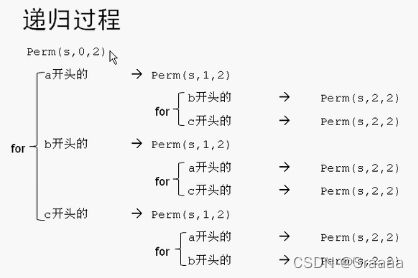数据结构与算法(C++实现)
目录
- 1.常见算法
-
- 1.1最基础的算法-swap(交换)
-
- 1.1.1 swap语法:
- 1.1.2 值传递方式(不成功):
- 1.1.3 传指针方式
- 1.1.4 引用的方式
- 1.1.5 使用宏定义函数
- 1.1.6 使用std::swap函数(最简便)
- 1.2 排序算法
-
- 1.2.1 冒泡排序
- 1.2.2 选择排序
- 1.2.3 插入排序
- 1.2.4 快速排序
- 1.2.5 归并排序
- 1.3 查找算法
-
- 1.3.1 顺序查找
- 1.3.2 折半查找(二分查找)
- 2.递归
-
- 2.1 用递归计算阶乘
- 2.2 用迭代(循环)计算阶乘
- 2.3 递归算法-折半查找
- 2.4 递归算法-permutation(排列组合)
- 3.栈和队列
-
- 3.1 栈
- 3.2 队列
- 4.链表
-
- 4.1链表基础知识
- 4.2 链表的插入操作
-
- 4.2.1 指定位置的插入
- 4.2.2 指定位置的删除
- 4.3链表的构造
1.常见算法
1.1最基础的算法-swap(交换)
1.1.1 swap语法:
int main() {
int a=1,b=10,temp;
temp=a;
a=b;
b=temp;
cout<<"a="<<a<<" b="<<b<<endl;
system("pause");
return 0;
}
1.1.2 值传递方式(不成功):
void swap1(int x,int y);
int main() {
int a,b;
a=1;
b=10;
cout<<"一个不成功的swap方法"<<endl;
cout<<"a="<<a<<" b="<<b<<endl;
swap1(a,b);//此处参数是按值传递的方式,将a和b各拷贝一个传递进去并进行交换
//所以发生变化的是拷贝的a和b,输出的a和b未发生改变
cout<<"a="<<a<<" b="<<b<<endl;
system("pause");
return 0;
}
void swap1(int x,int y)
{
int temp;
temp=x;
x=y;
y=temp;
}
输出:
一个不成功的swap方法
a=1 b=10
a=1 b=10
1.1.3 传指针方式
void swap1(int *x,int *y);
int main() {
int a,b;
a=1;
b=10;
cout<<"a="<<a<<" b="<<b<<endl;
swap1(&a,&b);//因为swap1函数的参数是指针,因此这里需要是地址传递
cout<<"a="<<a<<" b="<<b<<endl;
system("pause");
return 0;
}
void swap1(int *x,int *y)
{
int temp;
temp=*x;
*x=*y;
*y=temp;
}
输出:
a=1 b=10
a=10 b=1
1.1.4 引用的方式
void swap1(int &x,int &y);
int main() {
int a,b;
a=1;
b=10;
cout<<"a="<<a<<" b="<<b<<endl;
swap1(a,b);//因为引用就是别名,因此可以直接传递
cout<<"a="<<a<<" b="<<b<<endl;
system("pause");
return 0;
}
void swap1(int &x,int &y)
{
int temp;
temp=x;
x=y;
y=temp;
}
输出:
a=1 b=10
a=10 b=1
1.1.5 使用宏定义函数
各种类型都可以用,无论 int 或 double 等。
#define SWAP(x,y,t)((t)=(x),(x)=(y),(y)=(t))
int main() {
int a,b,temp;
a=1;
b=10;
cout<<"a="<<a<<" b="<<b<<endl;
SWAP(a,b,temp);
cout<<"a="<<a<<" b="<<b<<endl;
system("pause");
return 0;
}
输出:
a=1 b=10
a=10 b=1
1.1.6 使用std::swap函数(最简便)
各种类型都可以用,无论 int 或 double 等。
int main() {
int a,b;
a=1;
b=10;
cout<<"a="<<a<<" b="<<b<<endl;
std::swap(a,b);//C++内已经有这个函数,不用我们再自己写。直接调用即可
cout<<"a="<<a<<" b="<<b<<endl;
system("pause");
return 0;
}
输出:
a=1 b=10
a=10 b=1
1.2 排序算法
1.2.1 冒泡排序
思想:从左向右扫描数据,选择最大的数据,放在右边;
要点:比较相邻的两个数,如果左边的数大于右边的数,就进行交换。
法1:
//函数声明
void bubblesort(int list[],int n); //list是一个数组,n代表数组元素的个数
int main() {
int a[]={2,4,6,8,0,1,3,5,7,9};
bubblesort(a,10);
for(int k=0;k<10;k++)
{
cout<<a[k]<<" ";
}
system("pause");
return 0;
}
void bubblesort(int list[],int n) //函数定义
{
for(int i=0;i<n-1;i++)
{
//如果有10个数据,则一共需要扫描9遍
//每一遍扫描都是从list[0]开始,
//第一遍扫描:从list[0]扫到list[9]
//第二遍扫描:从list[0]到list[8];以此类推
for(int j=0;j<n-i-1;j++)
{
if(list[j]>list[j+1])
{
std::swap(list[j],list[j+1]);
};
}
}
}
输出:
0 1 2 3 4 5 6 7 8 9
法2:
int main() {
int arr[9]={4,2,8,0,5,7,1,3,9}; //1.创建数组
cout<<"排序前:";
for(int i=0;i<9;i++)
{
cout<<arr[i]<<" ";
}
cout<<endl;
//2.开始排序
//总共排序轮数=元素个数-1
for(int i=0;i<9-1;i++)
{
//内层循环对比次数=元素个数-当前轮数-1
for(int j=0;j<9-i-1;j++)
{
if(arr[j]>arr[j+1]) //如果第一个数字比第二个数字大,则交换两个数字
{
int temp=arr[j];
arr[j]=arr[j+1];
arr[j+1]=temp;
}
}
}
cout<<"排序后:";
for(int i=0;i<9;i++)
{
cout<<arr[i]<<" ";
}
system("pause");
return 0;
}
1.2.2 选择排序
从当前未排序的整数中找一个最小的整数,将它放在已排序的整数列表的后面。
要点:每次扫描只进行一次交换;选则一个最小的,放在左边。
void selectsort(int *a,const int n); //函数声明
int main() {
int a[]={1,3,5,7,9,0,2,4,6,8};
selectsort(a,10);
for(int k=0;k<10;k++)
{
cout<<a[k]<<" ";
}
system("pause");
return 0;
}
void selectsort(int *list,const int n) //函数定义
{
for(int i=0;i<n;i++)
{
int min=i;//把min看做一条毛巾,对数据做记号,暂定认为list[min]最小
for(int j=i+1;j<n;j++)//第二遍扫描时,从第二个元素即list[1]开始
{
if(list[j]<list[min])
{
min=j;//扫描中发现list[j]比之前暂定的最小值还要小,就把最小值替换为list[j]
}
}
swap(list[i],list[min]);
}
}
1.2.3 插入排序
//设房间里有n个人,是无序状态,他们要依次到房间外进行有序排队
void insert( int *a,int n);
int main() {
int x[]={2,4,6,8,0,1,3,5,7,9};
insert(x,10);
for(int i=0;i<10;++i)
{
cout<<x[i]<<" ";
}
system("pause");
return 0;
}
void insert( int *a,int n)
{
int in,out;//out代表房间内未排队的人,in代表房间外已经排好队的人
//开始时,out=0这个人已经出去了
for(out=1;out<n;++out)
{
int temp=a[out];
in=out;
while(in>0 && a[in-1]>=temp)
{
a[in]=a[in-1];
--in;
}
a[in]=temp;
}
}
输出:
0 1 2 3 4 5 6 7 8 9
1.2.4 快速排序
最流行的排序算法、速度最快的排序算法;
运用递归思路。
1.2.5 归并排序
1.3 查找算法
1.3.1 顺序查找
没有排序的数据,只能进行顺序查找;
顺序查找速度较慢,二分查找速度比较快;
有排序的数据,可以进行顺序查找和二分查找。
//顺序查找
int sequent(int *a,const int n,const int x); //所要查找的数值是x
int main() {
int m[]={1,3,5,7,9,0,2,4,6,8};
int result;
result=sequent(m,10,3);
if(result==-1)
{
cout<<"没找到该数值"<<endl;
}
else
{
cout<<"所找数值在m["<<result<<"]里"<<endl;
}
system("pause");
return 0;
}
int sequent(int *a,const int n,const int x)
{
int i;
for( i=0;i<n;i++)
{
if(a[i]==x)
{
return i;//如果找到x,则返回下标i
}
}
if(i==n) //如果没找到x,则返回-1
{
return -1;
}
}
1.3.2 折半查找(二分查找)
二分查找,速度比较快。
int binary(int *a,const int n,const int x); //用指针*a表示数组;n是数组元素个数;x是要查找的数据
int main() {
int m[]={1,3,5,7,9,0,2,4,6,8};
int result;
result=binary(m,10,7);
if(result==-1)
{
cout<<"没找到该数值"<<endl;
}
else
{
cout<<"所找数值在m["<<result<<"]里"<<endl;
}
system("pause");
return 0;
}
int binary(int *a,const int n,const int x)
{
int low,high,mid;//分别表示最小的下标、最大的下标、下标中间值
low=0; high=n-1;
while(low<=high)
{
mid=(low+high)/2;
if(a[mid]==x)
{
return mid;
}
else if(a[mid]<x)
{
low=mid+1;
}
else
{
high=mid-1;
}
}
return -1;
}
输出:
所找数值在m[3]里
2.递归
递归,就是在运行的过程中调用自己。
一个简单例子:
void a()
{
cout<<"hello"<<endl;
a();//自己又调用了自己
}
int main() {
a();
system("pause");
return 0;
}
2.1 用递归计算阶乘
//5!= 5*4*3*2*1
//5! = 5*4! 4!=4*3! 3!=3*2! 2!=2*1! 1!=1*0! 0!=1
//n! = n*(n-1)!
long int JC(int n)
{
if(n==0)
{
return 1;
}
else
{
return n*JC(n-1);
}
}
int main() {
cout<<JC(5)<<endl; //5的阶乘
for(int num=0;num<10;num++) //0-9的阶乘
{
cout<<num<<"!="<<JC(num)<<endl;
}
system("pause");
return 0;
}
输出:
120
0!=1
1!=1
2!=2
3!=6
4!=24
5!=120
6!=720
7!=5040
8!=40320
9!=362880
2.2 用迭代(循环)计算阶乘
long int JC(int n)
{
long r=1;
for(int i=n;i>0;i--)
{
r=r*i;
}
return r;
}
int main() {
cout<<JC(5)<<endl; //5的阶乘
for(int num=0;num<10;num++) //0-9的阶乘
{
cout<<num<<"!="<<JC(num)<<endl;
}
system("pause");
return 0;
}
输出:同上
2.3 递归算法-折半查找
int binary(int *a,const int n,const int x); //迭代(循环)方式
int binary1(int *a,const int x,const int low,const int high);//递归方式
int main() {
int m[]={1,3,5,7,9};
int result;
result=binary1(m,7,0,4);//递归方式
if(result==-1)
{
cout<<"没找到该数值"<<endl;
}
else
{
cout<<"所找数值在m["<<result<<"]里"<<endl;
}
system("pause");
return 0;
}
int binary(int *a,const int n,const int x) //迭代(循环)的方式
{
int low,high,mid;//分别表示最小的下标、最大的下标、下标中间值
low=0; high=n-1;
while(low<=high)
{
mid=(low+high)/2;
if(a[mid]==x)
{
return mid;
}
else if(a[mid]<x)
{
low=mid+1;
}
else
{
high=mid-1;
}
}
return -1;
}
int binary1(int *a,const int x,const int low,const int high)//递归方式
{
if(low<=high)
{
int mid=(low+high)/2;
if(x<a[mid])
{
return binary1(a,x,low,mid-1);
}
else if(x>a[mid])
{
return binary1(a,x,mid+1,high);
}
else
{
return mid;
}
}
return -1;
}
输出:
所找数值在m[3]里
2.4 递归算法-permutation(排列组合)
//对abc进行排列组合
void permutation( char *p,const int m,const int n)//m和n代表数组元素下标
{
if(m==n)
{
for(int i=0;i<=n;i++)
{
cout<<p[i];
}
cout<<endl;
}
else
{
for(int i=m;i<=n;i++)
{
swap(p[m],p[i]);
permutation(p,m+1,n);
swap(p[m],p[i]);
}
}
//swap(p[0],p[0]);
//permutation(p,1,2);
//swap(p[0],p[0]);//以a开头,后面跟着bc的所有排列
//swap(p[0],p[1]);
//permutation(p,1,2);
//swap(p[0],p[1]);//以b开头,后面跟着ac的所有排列
//swap(p[0],p[2]);
//permutation(p,1,2);
//swap(p[0],p[2]);//以c开头,后面跟着ab的所有排列
}
int main() {
char s[]="abc";
permutation(s,0,2);
system("pause");
return 0;
}
abc
acb
bac
bca
cba
cab
3.栈和队列
3.1 栈
3.2 队列
4.链表
4.1链表基础知识
- 数组是最常用的数据结构,但存在缺点。例如在一个有序数组中插入新数据或删除某数据时,将会使很多数据发生移动,导致效率降低。
- 链表是第二常用的数据结构。
- 链表中插入或删除一个数据,只需要修改该数据相邻数据的指针指向即可,不需要移动其他数据的位置。

- 链表就是表头指针和一串相继链接的结点的总称。
- 链表每个节点都包含数据域和指针域。
- 首指针(表头指针) :指向链表的第一个结点的指针变量。 其值为首结点的存储地址。.
- 表尾结点(最后一个结点)的链域值为空(NULL)

4.2 链表的插入操作
4.2.1 指定位置的插入
p->next=head; //先把陈与张连接,使结点张作为结点陈的后继节点
head=p; //修改表头指针head,使其指向新的头结点陈
插在表中:如图,把陈插到王和李之间
p->next=q->next; //先把陈与李连接
q->next=p; //再把王与陈连接
4.2.2 指定位置的删除
删除表头结点:
q=head; //为了回收空间,先用q指针记住表头张
head=head->next; //修改head,使其指向新的表头结点
free(q); //将空间回归
p=q->next; //先用p指针记住结点李
//此时结点赵的地址是p->next,也是q->next->next
q->next=p->next; //将结点王的后继结点修改为结点赵,即删除了结点李
free(p); //将空间回收
链表的特点:
- 结点地址不连续
- 插入/删除不移动结点,耗时为O(1)
- 用于动态管理。
4.3链表的构造
构造链表的通用算法
- 构造“空链表”
- 读入第一个元素值。
- 当读入的元素值不是“输入结束标记”时,循环执行步骤4~7。
- 申请一个新结点。
- 将读入的元值存入新结点的值域。
- 将新结点“插在”链表中。
- 读入“下一个”元素值,转步骤3。
- 构造完毕,返回首指针。





